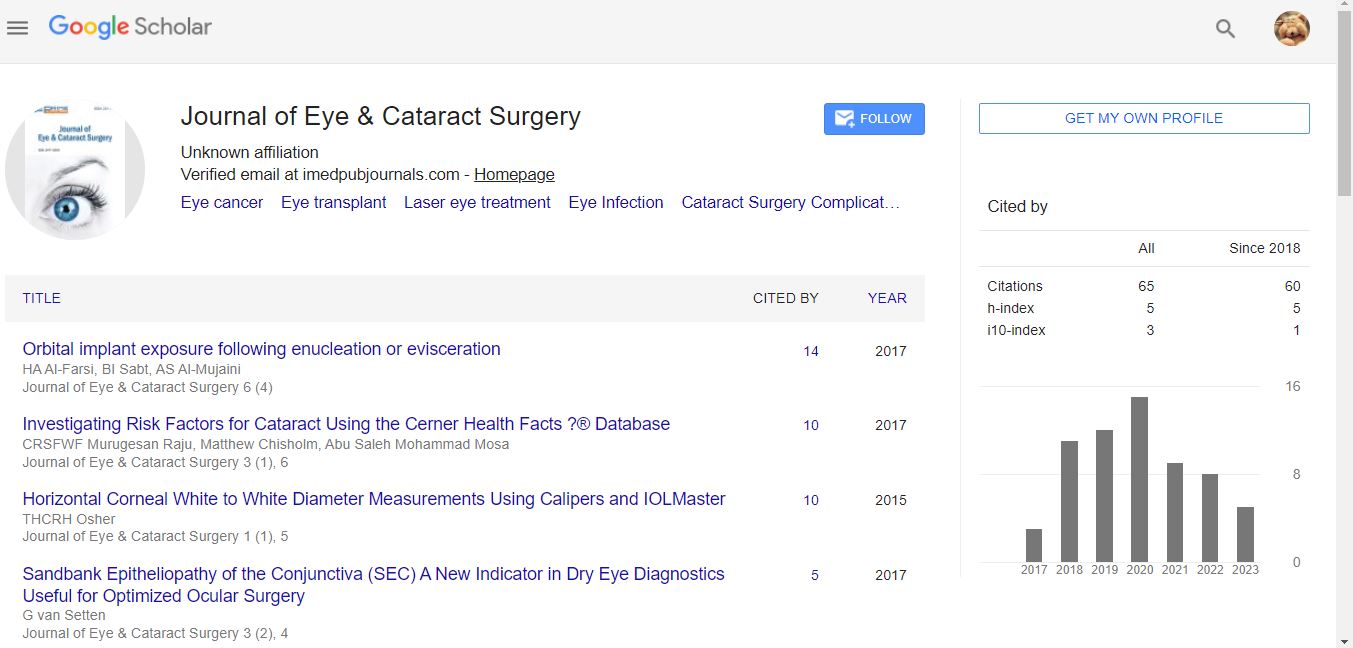Perspective - (2024) Volume 10, Issue 3
The Importance of Corneal Thickness in Ocular Health: Implications for Diagnosis and Treatment
Grant Silas*
Department of Ophthalmology, University of Health Sciences, USA
*Correspondence:
Grant Silas,
Department of Ophthalmology, University of Health Sciences,
USA,
Email:
Received: 02-Sep-2024, Manuscript No. IPJECS-24-21685;
Editor assigned: 04-Sep-2024, Pre QC No. IPJECS-24-21685 (PQ);
Reviewed: 18-Sep-2024, QC No. IPJECS-24-21685;
Revised: 23-Sep-2024, Manuscript No. IPJECS-24-21685 (R);
Published:
30-Sep-2024, DOI: 10.36648/2471-8300.10.3.25
Description
Corneal thickness is a critical parameter in the assessment of
ocular health and plays a significant role in various aspects
of eye care, from diagnosing refractive errors to evaluating
the risk of glaucoma and planning surgical interventions. The
cornea, the transparent front part of the eye, serves as the
eye’s primary refractive surface and acts as a protective barrier
against environmental hazards. Its thickness can vary among
individuals and can be influenced by age, gender, and certain
ocular conditions. Understanding corneal thickness is essential
for both clinicians and patients in managing a range of eye
health issues. Thinner corneas can yield falsely low readings,
potentially delaying a proper diagnosis and treatment. Thus,
ophthalmologists must consider when evaluating patients
for glaucoma, and some practitioners may even adjust their
measurements based on corneal thickness. Refractive surgery,
including procedures such as Laser-Assisted. In Situ Keratomileusis
and Photorefractive Keratectomy, also relies heavily on corneal
thickness measurements. Before undergoing these procedures,
patients must be evaluated for corneal thickness to ensure they
have sufficient corneal tissue for safe and effective surgery. If the
cornea is too thin, the risk of complications, such as ectasia an
abnormal bulging of the cornea may increase. A comprehensive
preoperative assessment, including corneal mapping and
pachymetry, is crucial to determining the suitability of candidates
for refractive surgery. Beyond glaucoma and refractive surgery,
corneal thickness can influence the management of other ocular
conditions. For instance, in keratoconus, a progressive disease
characterized by thinning and cone-shaped deformation of
the cornea, monitoring corneal thickness is vital for tracking
disease progression and planning interventions. Patients with
keratoconus often require specialized contact lenses or corneal
cross-linking procedures, which aim to strengthen corneal tissue
and halt the progression of the disease. Corneal thickness is also
essential in the context of post-operative care. After cataract
surgery, for example, changes in corneal thickness can occur due
to surgical trauma or inflammation. Monitoring these changes
helps clinicians anticipate potential complications such as corneal
oedema, which can affect visual recovery. By keeping track of
corneal thickness, eye care professionals can intervene promptly,
ensuring optimal outcomes for their patients. The advancement
of technology has facilitated the precise measurement of corneal
thickness. Devices such as optical coherence tomography and
Scheimpflug imaging provide high-resolution, detailed maps of
the cornea, allowing for comprehensive assessments. These
innovations enable clinicians to detect subtle changes in corneal
structure and thickness, improving the early diagnosis of diseases
and refining surgical planning. Patient education regarding
corneal thickness is essential for fostering understanding and
compliance with recommended treatments. Individuals with
conditions affecting corneal thickness, such as glaucoma or
keratoconus, should be informed about the implications of
their corneal measurements and the importance of regular eye
examinations. In conclusion, corneal thickness is a vital aspect
of ocular health, influencing various clinical considerations from
glaucoma assessment to refractive surgery and beyond. As
research continues to evolve, a deeper understanding of corneal
thickness will enhance diagnostic capabilities and treatment
strategies in ophthalmology. Regular monitoring and accurate
measurement of corneal thickness are crucial for optimizing
patient care and ensuring favourable outcomes in a range of eye
health scenarios.
Acknowledgement
None.
Conflict Of Interest
None.
Citation: Silas G (2024) The Importance of Corneal Thickness in Ocular Health: Implications for Diagnosis and Treatment. J Eye
Cataract Surg. 10:25.
Copyright: © 2024 Silas G. This is an open-access article distributed under the terms of the Creative Commons Attribution Li�cense, which permits unrestricted use, distribution, and reproduction in any medium, provided the original author and source
are credited.

